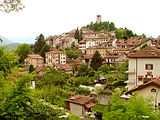Feltre
| Feltre | ||
|---|---|---|

|
|
|
| Country | Italy | |
| region | Veneto | |
| province | Belluno (BL) | |
| Local name | Feltre | |
| Coordinates | 46 ° 1 ' N , 11 ° 54' E | |
| height | 325 m slm | |
| surface | 100 km² | |
| Residents | 20,564 (Dec. 31, 2019) | |
| Population density | 206 inhabitants / km² | |
| Post Code | 32032 | |
| prefix | 0439 | |
| ISTAT number | 025021 | |
| Popular name | Feltrini | |
| Patron saint | St. Viktor | |
| Website | Feltre | |
Feltre (German outdated "Felters") is a town with 20,564 inhabitants (as of December 31, 2019) in the Italian province of Belluno , Veneto region .
geography
The city is located at an altitude of 325 m slm on a tributary of the Piave on the foothills of the Dolomites . The municipality covers an area of approx. 100 km², its population density is 203 inhabitants / km².
The city is a regional center of the metal industry and the seat of the private university IULM (Libera Università di Lingue e Comunicazione ; headquarters: Milan ), which Carlo Bo co-founded . The historic upper town with houses from the Renaissance and sgraffito decorations that are well worth seeing lies on a narrow ridge.
Neighboring municipalities are Cesiomaggiore , Fonzaso , Borgo Valbelluna , Mezzano , Pedavena , Quero Vas , Seren del Grappa and Sovramonte .
history
The name of the city comes from the Etruscans , who called them "Felthuri" or "Velhatre". In Roman times it was known under the name "Feltria", as described in the Historia Naturalis by Pliny (III, 130). It was on the Via Claudia Augusta , an important Roman road from Aquileia to Augsburg .
In 1404 Feltre fell to the Republic of Venice together with Belluno . In 1509 the city was completely destroyed by the troops of Maximilian I of Austria on his campaign against Venice.
In 1797 the city was conquered by France and became part of Austria-Hungary after the Congress of Vienna . It was annexed by Italy in 1866 and has officially been part of Italy since the end of the First World War .
During the Second World War , the last personal meeting between Hitler and Mussolini on Italian soil took place on July 19, 1943 in Feltre . The reason was the increasing threat to southern Italy, particularly Sicily, from the Allies and the beginning of the withdrawal of the Wehrmacht on the Eastern Front shortly after the defeat at Stalingrad . The opposing goals of the allies brought Mussolini into a conflict of interests, which led to his dismissal by the Fascist Grand Council and his arrest on July 25, 1943.
Culture and sights
- The Cathedral of San Pietro is outside the city walls. From the previous building, which was destroyed by the troops of Maximilian I in 1510, the crypt and the raised choir above are still preserved. The choir consists of the main and two side chapels. In it is the grave monument for Matteo Belatti (1525) by Tullio Lombardo on the right . Two altarpieces by Pietro Marescalchi , Mercy (1557) and John the Baptist (1567), are in the right aisle.
traffic
The Ferrovia Decauville Feltre – Fonzaso – Fastro was a field railway built during the First World War by the Italian armed forces with a gauge of 600 mm.
Personalities
- Enrico dal Covolo SDB (* 1950), Roman Catholic theologian and since 2010 Rector of the Pontifical Lateran University
- Bruno Debertolis (* 1978), cross-country skier
- Stefano Doglioni (* 1986), jazz musician
literature
- Klaus Zimmermanns: Venetia - The cities and villas of the Terraferma. Cologne 2009, ISBN 978-3770143566 , pp. 305-309.
- Reclam's art guide. Northern Italy East. Arranged by Erich Egg, Erich Hubala u. a., Stuttgart 1965, pp. 184-189.
Individual evidence
- ↑ Statistiche demografiche ISTAT. Monthly population statistics of the Istituto Nazionale di Statistica , as of December 31 of 2019.


